Aust.TacticalAssaultGroupAust.TAGFar North Queensland Regiment
![]()
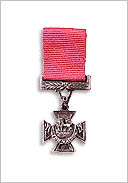 Victoria Cross for Australia (VC)
Victoria Cross for Australia (VC)
The Victoria Cross for Australia was established as part of the Australian system of honours and awards on 15 January 1991. It replaced the Victoria Cross which still forms part of the imperial system of honours. The Victoria Cross was created by Queen Victoria in 1856.
The Victoria Cross recognises persons who perform an act of the most conspicuous gallantry or daring or pre-eminent acts of valour or self-sacrifice or display extreme devotion to duty.
97 Australians have been awarded the Victoria Cross, the last Australian being Warrant Officer Keith Payne in 1969 during the Vietnam War.
![]()
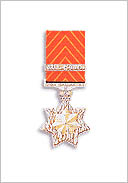 Star of Gallantry (SG)
Star of Gallantry (SG)
For acts of great heroism or conspicuous gallantry in action in circumstances of great peril
![]()
 Medal for Gallantry (MG)
Medal for Gallantry (MG)
For acts of gallantry in action in hazardous circumstances
![]()
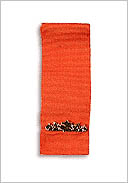 Commendation for Gallantry
Commendation for Gallantry
For other acts of gallantry which are considered worthy of recognition
![]()
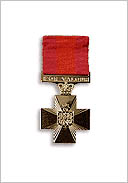 The Cross of Valour (CV)
The Cross of Valour (CV)
Awarded for acts of conspicuous courage in circumstances of extreme peril
![]()
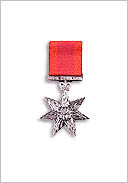 The Star of Courage (SC)
The Star of Courage (SC)
Given for acts of conspicuous courage in circumstances of great peril
![]()
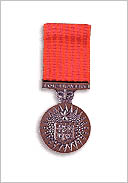 The Bravery Medal (BM)
The Bravery Medal (BM)
Offered for acts of bravery in hazardous circumstances
![]()
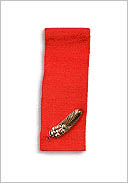 The Commendation for Brave Conduct
The Commendation for Brave Conduct
Conferred for other acts of bravery that are considered worthy of recognition
![]()
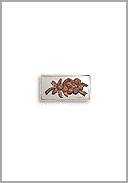 Group Citations
Group Citations
In addition to individual awards for bravery, a collective act of bravery by a group of persons in extraordinary circumstances may have their actions recognised by a Group Bravery Citation.
![]()
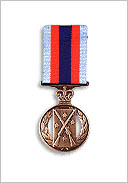 Champion Shots Medal
Champion Shots Medal
This Medal was established in 1988 to recognise skill at arms in the Australian Defence Force. Each year, target-shooting competitions are held with standard issue weapons conducted by each arm of the Defence Force.
Three Medals - one for each Service - are awarded annually to the winner of the Champion Shot competition.
The award of the Medal is made with a clasp to denote the year of the competition and any subsequent award to the same person is made in the form of another clasp.
![]()
 Unit Citations
Unit Citations
These citations were established in 1991 to recognise gallantry in action or outstanding service in warlike operations by units of the Australian Defence Force and/or units of the defence forces of other countries.
There are two citations:
Unit Citation for Gallantry - for extraordinary gallantry in action.
Meritorious Unit Citation - for sustained outstanding service in warlike operations.
Each Citation consists of a certificate of citation to the Unit signed by the Governor-General and insignia for each recipient.
Insignia may be awarded posthumously.
Three recent examples of the award of the Meritorious Unit Citation occurred during the Australian Defence Force's deployment to East Timor following the 1999 consultation ballot:
Task Unit 645.1.1, Royal Australian Navy - For sustained outstanding service in warlike operations in support of the International Force East Timor during Operation STABILISE.
3 Squadron Group, the Special Air Service Regiment - Australian Army - For sustained outstanding service in warlike operations as the Special Air Service Regiment of the Response Force for Operation WARDEN.
No 2 Airfield Defence Squadron, Royal Australian Air Force - For sustained outstanding service in warlike operations in support of the International Force East Timor during Operation WARDEN and Operation STABILISE.
![]()
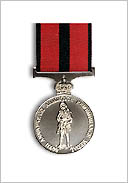 80th Anniversary Armistice Remembrance Medal
80th Anniversary Armistice Remembrance Medal
On 11 November 1998 the Prime Minister the Hon John Howard MP announced that the government would recommend to The Queen that a special commemorative medal would be struck for all surviving Australian World War I veterans who commemorated the 80th anniversary of the armistice that ended the Great War. The Queen approved the Medal design and regulations on
7 January 1999 and it became the first commemorative medal in the Australian system of honours and awards.
The Medal was manufactured in record time which enabled all surviving veterans to be personally presented with their Medals prior to Anzac Day 1999 by either the Prime Minister, the Minister for Veterans' Affairs or other members of the government. In all, only 70 Medals were presented to veterans who are a living reminder to all Australians three generations on of a conflict that gave birth to the Anzac tradition and marked Australia's nationhood on the world stage.
The Medal's design features on the obverse the statue of the "Bullecourt Digger" and the reverse depicts the apt words "LEST WE FORGET" surrounded by a spray of wattle. The ribbon colours of red and black mirror those of the poppy flower worn as a mark of respect by so many Australians each year on Remembrance Day.
![]()
 Anniversary of National Service Medal 1951-1972
Anniversary of National Service Medal 1951-1972
On 26 April 2001, the Prime Minister announced the Anniversary of National Service 1951 - 1972 Medal. The Medal was created to recognise the service of more than 300,000 national servicemen between 1951 and 1972.
The Medal is a way to publicly acknowledge those who played such an important role in the defence of our nation through the two post-war national service schemes. Of the 325,800 national servicemen over the 21-year period,
187 gave their lives on active service and some 1,500 were wounded.
The Medal joins the honours and medals awarded to full and part-time members of the Australian Defence Force, both current and former. These include gallantry and bravery decorations, distinguished, conspicuous and meritorious service decorations, service and campaign medals and commemorative medals.
Former national servicemen can now apply for the Medal at the following address. The next of kin of those who have died may also apply for the Medal.
![]()
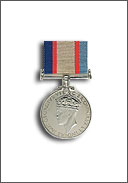 Australia Service Medal 1939-1945
Australia Service Medal 1939-1945
This Medal can claim to be the first truly distinctive Australian medal. The Medal was created by King George VI in 1949 and counter signed by Prime Minister Ben Chifley to recognise World War II service by members of Australia's armed forces and the Volunteer Defence Corps.
This Medal was in addition to a range of British medals and campaign stars that could be earned by Australians for service in World War II. The qualifying service criteria for the Medal - 18 months for full-time service or 3 years for part-time service - was amended in 1996 to 30 days and 90 days respectively.
Applications for this Medal can be obtained from the relevant service medals sections in the Department of Defence, Canberra.
![]()
 Australian Active Service Medal 1945 - 1975
Australian Active Service Medal 1945 - 1975
Prime Minister John Howard announced the establishment of this active service medal in December 1997 to recognise the service of veterans who served in the Korean War, the Malayan Emergency, the Indonesian Confrontation and the Vietnam War.
The establishment of this new medal followed on from the government's 1996 election commitment to the veterans' community to create a distinctly Australian award to recognise warlike service between 1945 and 1975.
Those veterans who received, or have an entitlement to the Korean Medal, a General Service Medal for service in the Malayan Emergency 1948-60 or the Indonesian Confrontation 1962-66, are eligible for this Australian Active Service Medal 1945-1975.
When the Prime Minister announced The Queen's formal approval of this Medal, he also indicated that the Medal would be extended to those personnel who have received the Vietnam Medal and for some categories who have recieved the Vietnam Logistic and Support Medal.
This Australian Active Service Medal 1945-1975 is placed at the same level as other war medals and the Australian Active Service Medal in the order of wearing medals. It is worn immediately after World War II medals but before the Korean War Medal, the General Service Medals, the Vietnam Medal and the Vietnam Logistic and Support Medal.
The Medal has the following clasps:
Korea
Malaya
Malaysia
Thai/Malay
Thailand
Vietnam
![]()
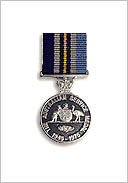 Australian Service Medal 1945-1975
Australian Service Medal 1945-1975
The Australian Service Medal 1945-1975 was established in 1995 to recognise a large number of Australian service personnel who did not receive any award for their non-warlike operational service in the period 1945-1975. The creation of this award was one of the recommendations of the Committee of Inquiry into Defence Awards that reported to government in 1994.
The award's aim is to recognise service in prescribed peacekeeping or non-warlike operations during the period 1945-1975 where recognition had not been extended previously through an award.
The Medal's design features the Commonwealth Coat of Arms on the obverse and is ensigned with the Crown of Saint Edward. The reverse of the Medal features the Federation Star overlaid with a plinth on which the wearer's name is engraved. The obverse and reverse are decorated with clusters of mimosa blossoms symbolising the presence of Australian service personnel in overseas peacekeeping and other non-warlike operations. The ribbon has bands of dark and light blue, khaki, green and gold.
The Australian Service Medal 1945-1975 is placed on the same level as the Australian Service Medal in the Australian Order of Wearing Australian Honours and Awards.
The Governor-General has approved a number of clasps for the Medal including the following:
Berlin
FESR
Germany
Indonesia
Japan
Kashmir
Korea
Middle East
PNG
S E Asia
S W Pacific
Special Ops
Thailand
W New Guinea
![]()
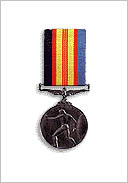 Vietnam Medal
Vietnam Medal
This Medal can claim to be the second award, following the Australia Service Medal 1939-1945, created in the Australian system of honours and awards. The Medal was approved in 1968 by The Queen and counter signed by Prime Minister Sir John Gorton.
The Medal was created to recognise the service of members of Australian Armed Forces and accredited members of approved philanthropic organisations serving with our service personnel in South Vietnam during the Vietnam War. Service is recognised between the dates 29 May 1964 and 27 January 1973.
Qualifying service includes:
28 days in ships or craft on inland waters or off the coast of Vietnam.
One day or more on the posted strength of a unit or formation on land.
One operational sortie over Vietnam or Vietnamese water by aircrew on the posted strength of a unit.
Official visits either continuous or aggregate of 30 days.
![]()
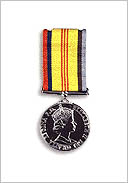 Vietnam Logistic and Support Medal
Vietnam Logistic and Support Medal
This Medal was created in 1992 to recognise the service of Australian personnel who served in support roles during the Vietnam War. When this Medal was put in place, it provided recognition to those Australian men and women who played a vital role in supporting the Vietnam campaign in difficult or potentially dangerous situations, but who did not qualify for the Vietnam Medal. It provided recognition in particular to personnel who served in naval ships providing logistic support to our troops in Vietnam.
The Medal was put in place following the persistence of a number of veterans' groups including from the HMAS Sydney and Vietnam Logistic Support Veterans' Association. The Vietnam Logistic and Support Medal is the same shape and size as the existing Vietnam Medal but with a distinctly different ribbon.
The qualifying criteria for the Medal is:
Service of one day or more as a member or crew of a ship or aircraft operating in the prescribed area of operations of Vietnam in support of Australian forces.
Service of one day or more within the prescribed area of operations of Vietnam while attached to a unit or organisation in support of Australian forces.
![]()
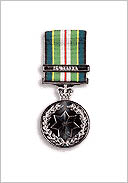 Australian Active Service Medal
Australian Active Service Medal
This Medal was created in 1988 to recognise prescribed service in warlike operations. The Medal is awarded with a clasp to denote the prescribed operation and subsequent awards of the Medal to the same person are made in the form of a further clasp to the Medal. The Governor-General makes awards of the Medal and clasps on the recommendation of the Chief of the Defence Force.
The Medal obverse features the Commonwealth Star enclosed by a wattle wreath symbolising the Australian nature of the award. The reverse shows a stylised laurel wreath around the inscription For Active Service. The colours of the ribbon are primarily variations of the Australian colours of green and gold with a central red stripe, which signifies active service, that is, the dangers faced in warlike situations.
The Governor-General has approved the following clasps as qualifying for the award of the Medal: 'Balkans', 'Cambodia', 'East Timor', ICAT, 'Kuwait', Namibia, 'Somalia' and 'Vietnam 1975'.
![]()
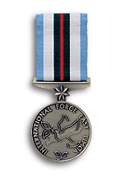 International Force East Timor Medal
International Force East Timor Medal
Prime Minister John Howard announced on 7 March 2000 the establishment of a specific campaign medal for members of the Australian Defence Force in East Timor. Personnel who served in the East Timor operation area during the INTERFET operation for 30 days or more will qualify for this campaign medal.
Australia led the INTERFET coalition of 17 nations.
Australia has invited other nations, which contributed personnel to INTERFET, to use the International Force East Timor Medal as a means of recognising their forces. This is the first time an Australian medal has been used in this way.
In addition to this Medal, the Australian Active Service Medal clasp "East Timor" will also be awarded to members of the ADF who participated in the INTERFET operational area of East Timor.
![]()
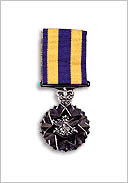 Defence Force Service Medal
Defence Force Service Medal
Awarded to all full-time service personnel.
![]()
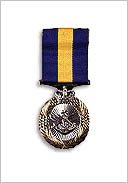 Reserve Force Decoration (RFD)
Reserve Force Decoration (RFD)
Awarded to Reserve Force officers.
![]()
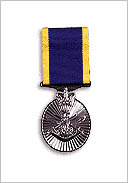 Reserve Force Medal
Reserve Force Medal
Awarded to Reserve Force other ranks.
![]()
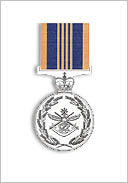 Defence Long Service Medal
Defence Long Service Medal
In 1998, a new Defence long service medal was approved by The Queen to replace the family of Defence Force Service Awards that recognised long service in the Australian Defence Force. The introduction of this new Defence long service medal was the result of a recommendation of the 1994 Committee of Inquiry into Defence and Defence Related Awards. The Medal will be awarded for 15 years' service and clasps are issued for each subsequent five years' service.
The new award will also allow recognition for service that might otherwise have gone unrecognised such as that previously lost by individuals who changed their service between Regular and Reserve Forces. This Medal does not discriminate between rank levels, Regular or Reserve service and does not carry a post-nominal entitlement.
![]()
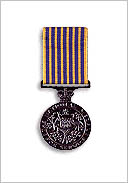 National Medal
National Medal
The National Medal was one of the first three elements of the Australian system of honours and awards introduced in early 1975. When the Medal was introduced it recognised 15 years' diligent service by members of the Defence Force, Australian police forces, and fire and ambulance services. In 1982, the Defence Force Service Awards provided for long service in the Australian Defence Force and eligibility for the National Medal was varied to enable persons who had participated in part-time and volunteer service in organisations other than the Defence Force to qualify for the National Medal. Progressively since then, members of the Australian Protective Service and correctional and emergency services have become eligible for the award the National Medal. A clasp to the Medal is given for each 10 years' additional service.
Following decisions of the government in 1997, the regulations for the National Medal underwent a comprehensive review and reworking. As a result The Queen approved new regulations in 1999.
Two significant new features of the National Medal are:
The regulations were amended to allow members of qualifying volunteer search and rescue groups to receive the Medal.
Provision was made for persons to more easily aggregate their service should they serve in different qualifying organisations for the Medal.
Since 1975, some 60,000 National Medals have been awarded for 15 years' diligent service and a further 25000 clasps to the Medal
![]()
 Australian Cadet Forces Service Medal
Australian Cadet Forces Service Medal
The Australian Cadet Forces Service Medal was created in December 1999. It recognises long and efficient service by officers and instructors in the Australian Cadet Forces.
The Medal is awarded for 15 years' efficient service and clasps are awarded for each further period of 5 years' efficient service. This Medal is the Australian successor to the British Cadet Forces Medal that ceased to be used in Australia in 1974.
The Medal ribbon features vertical stripes of gold and blue, the traditional colours for long service medals, with navy, red and blue stripes to signify links with the Royal Australian Navy, Australian Army and the Royal Australian Air Force. The Medal shows the Cadet Forces logo on the obverse and the federation star on the reverse.
![]()